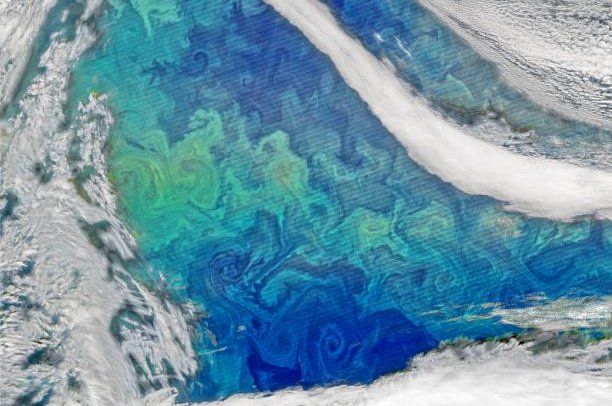1 of 3 | A color-enhanced image captured using VIIRS data from the Suomi National Polar-orbiting Partnership satellite reveals a phytoplankton bloom, the green portions, in the North Atlantic. Photo by NASA/Norman Kuring
WASHINGTON, Dec. 11 (UPI) -- A mass of phytoplankton recently appeared near the ocean surface in the North Atlantic, growing large enough to be seen from space.
Earlier this fall, the Visible Infrared Imaging Radiometer Suite, a camera on the Suomi National Polar-orbiting Partnership, or Suomi NPP, was able to image the phytoplankton bloom through a gap in the clouds.
The Suomi NPP is a weather satellite launched and managed by the National Oceanic and Atmospheric Administration.
Phytoplankton are tiny algae-like microorganisms that harvest sunlight for energy. They serve as the base of the marine food web. When temperatures rise and sunlight is plentiful in the spring and summer, the photosynthesizing microorganisms proliferate.
Blooms happen in the fall, too, but weather is often not clear enough for the events to be imaged from space.
"A lot of what we don't know about ocean ecology has to do with the difficulty of sampling the ocean," Norman Kuring, an ocean scientist at NASA's Goddard Space Flight Center, explained in a press release, "whether it be from a storm-tossed ship or from a cloud-obstructed satellite."
Phytoplankton and their bloom cycles are influence by more than just weather. Where they appear and how large they grow are also dependent on fluctuation of mineral concentrations in the water, as well as ocean currents and other physical factors.
"The image does a beautiful job of showing the close link between ocean physics and biology," said Michael Behrenfeld, a phytoplankton ecologist at Oregon State University. "The features that jump out so clearly represent the influence of ocean eddies and physical stirring on the concentration of phytoplankton pigments and, possibly,colored dissolved organic matter."
A few weeks after the Suomi NPP satellite imaged the bloom, a research ship deployed by NASA's North Atlantic Aerosols and Marine Ecosystems Study arrived on the scene. Scientists with NASA and NOAA are trying to better understand phytoplankton cycles by combining ship- and aircraft-based observations with satellite and ocean sensor data.















